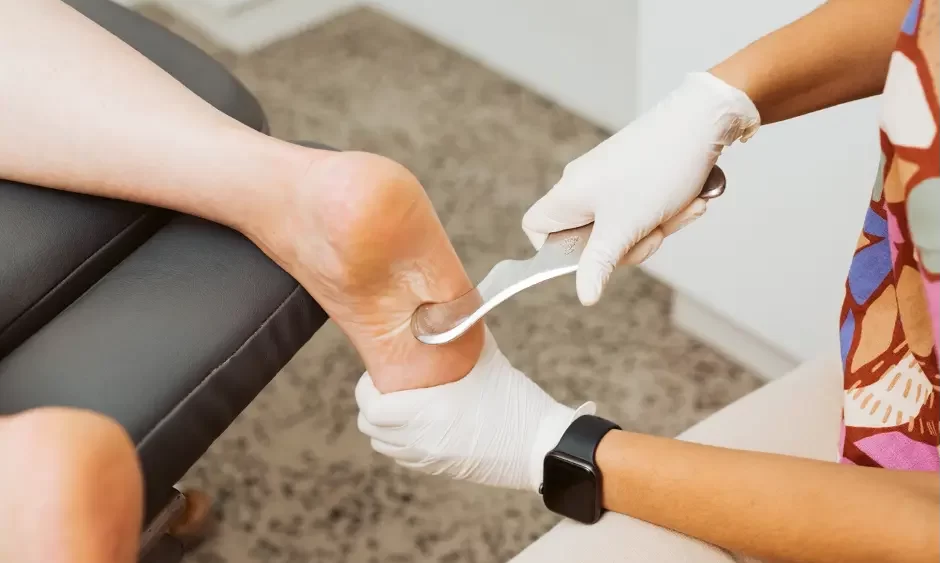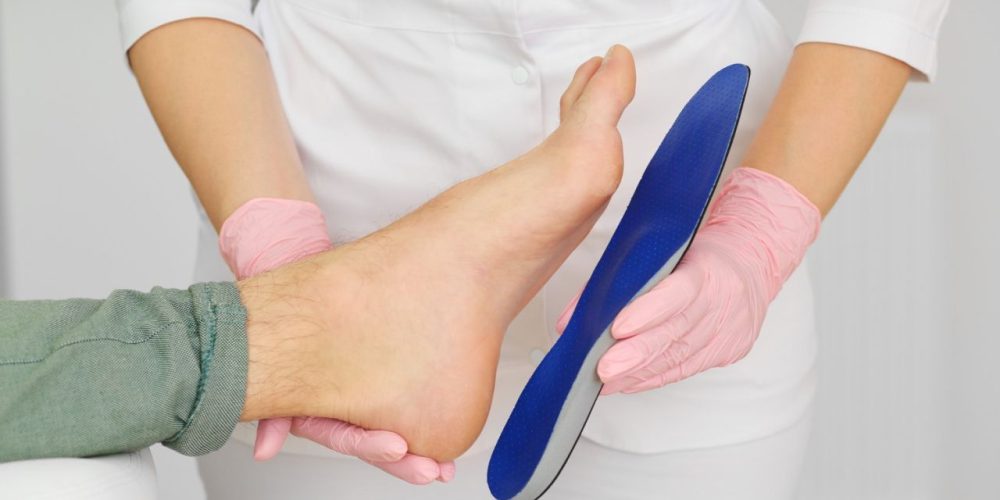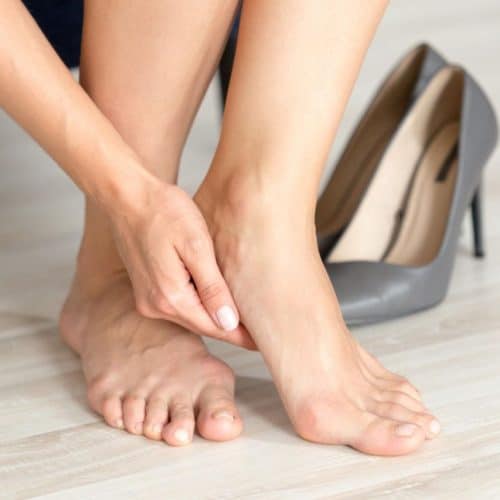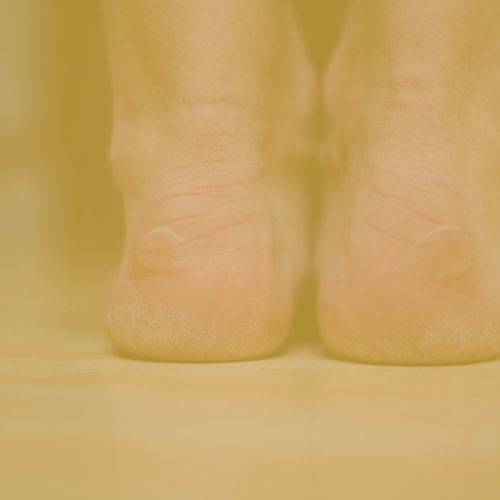Have you ever experienced persistent, nagging pain in your toes or the balls of your feet? That discomfort might be due to an often-misunderstood condition: Morton’s Neuroma. What’s causing that pain, and if there’s relief in sight? Let’s delve into the world of Morton’s Neuroma and unveil the reasons behind your toe and foot woes.
In a nutshell, Morton’s Neuroma stems from the thickening of the tissue surrounding a nerve that runs between your toes, commonly the third and fourth. This can result in sharp, burning pain or the sensation of stepping on a pebble, making every step an ordeal.
Understanding Morton’s Neuroma
Morton’s Neuroma is a painful and often misunderstood condition that primarily affects the forefoot, causing discomfort and distress for those who experience it. Named after Thomas George Morton, the American surgeon who first described the condition in the early 20th century, Morton’s Neuroma is characterised by the development of a benign growth or thickening of tissue around a nerve, usually located between the third and fourth toes. This growth puts pressure on the nerve, leading to uncomfortable symptoms that can significantly impact daily life.
The exact cause of Morton’s Neuroma is not fully understood, but it’s commonly associated with factors that increase pressure on the ball of the foot. One primary cause is ill-fitting footwear, particularly high heels and narrow-toed shoes. These shoes force the toes into a cramped position, leading to increased compression and irritation of the nerves. Additionally, activities that involve repetitive impact on the forefoot, such as running or participating in high-impact sports, can contribute to the development of Morton’s Neuroma.
As the neuroma progresses, individuals may experience shooting pain, burning, tingling, or numbness in the affected area. Some people describe feeling as stepping on a small pebble or having a sock bunched up under their feet. These sensations can be sharp and intense, making walking or standing for extended periods uncomfortable.
One key aspect is that Morton’s Neuroma is not a tumour or cancerous growth. Instead, it’s a benign enlargement of the nerve sheath, typically caused by chronic irritation. If left untreated, the symptoms can worsen over time, leading to increased pain and potential limitations in mobility.
It’s essential to seek medical attention if you suspect you have Morton’s Neuroma or are experiencing persistent foot pain. A healthcare practitioner, often a podiatrist or orthopedic specialist, can provide a proper diagnosis through a physical examination and may use imaging techniques like X-rays or MRI scans to confirm the condition and rule out other possible causes of foot pain.
Causes of Morton’s Neuroma
Understanding the underlying causes of Morton’s Neuroma is crucial in effectively managing and preventing this uncomfortable condition. While it’s often related to footwear choices, several factors contribute to developing this nerve-related ailment.
1. Footwear Choices
One of the most common culprits behind Morton’s Neuroma is wearing ill-fitting footwear, particularly shoes that cramp the toes and increase pressure on the forefoot. High heels, for instance, force the toes into a downward angle, causing the metatarsal bones to push against the nerve. Similarly, shoes with a narrow toe box squeeze the toes together, leading to nerve compression and subsequent irritation. Long-term use of such footwear can trigger the growth of a neuroma.
2. Foot Mechanics and Biomechanics
The mechanics of your feet can also play a significant role in the development of Morton’s Neuroma. Conditions that alter how you walk or distribute weight across your feet, such as having flat feet or high arches, can contribute to uneven pressure distribution on the metatarsal heads. This uneven pressure can lead to nerve irritation and neuroma formation.
3. Repetitive Impact and Activities
Engaging in activities that involve repetitive impact on the forefoot can contribute to the onset of Morton’s Neuroma. Runners, for example, often experience this condition due to the constant pushing off of the toes during each stride. Similarly, sports that require quick pivots or movements that place stress on the front of the foot can increase the risk of nerve compression and subsequent irritation.
4. Footwear and Activities
It is conceivable that the chance of getting Morton’s Neuroma can be raised even higher when certain activities are coupled with wearing shoes that are not appropriate for the activity. This is because Morton’s Neuroma can grow in the nerve along the bottom of the foot.
For instance, if you engage in high-impact activities like running while simultaneously wearing high heels, you can contribute to the development of the disease by making the environment more favourable for its spread. If the heads of the metatarsal bones are exposed to an abnormally high amount of strain and pressure on a consistent basis, a neuroma may form over the course of time.
5. Genetic Predisposition
While the role of genetics in Morton’s Neuroma is not fully understood, some individuals might be genetically predisposed to developing the condition. Certain foot structures and biomechanical factors can run in families, increasing the likelihood of nerve compression and the subsequent growth of a neuroma.
6. Hormonal Changes
Interestingly, hormonal changes in the body can also contribute to the development of Morton’s Neuroma. Some studies suggest that hormonal fluctuations, particularly during pregnancy, can lead to changes in the foot’s connective tissues, potentially causing nerve compression.
Understanding these various causes can empower you to make informed choices that protect your foot health and reduce the risk of Morton’s Neuroma. You can take proactive steps toward preventing this uncomfortable condition by opting for well-fitting footwear, maintaining a healthy foot posture, and being mindful of activities that place excessive strain on the front of your feet.
Common Symptoms
Recognising the common symptoms of Morton’s Neuroma is essential for early detection and timely intervention. The discomfort caused by this condition can vary in intensity and frequency, impacting your daily activities and overall quality of life. Here’s a closer look at the symptoms you might experience when dealing with Morton’s Neuroma.
1. Sharp and Shooting Pain
The presence of piercing and penetrating pain in the ball of the foot, particularly in the space in between the third and fourth toes, is one of the telltale signs that a patient is suffering from Morton’s Neuroma.
This pain can come on suddenly and be quite acute; it is frequently compared to the sensation of having something sharp or electric protruding from within the foot. The discomfort may be intermittent, but it is likely to become more severe if you continue to wear shoes that crowd the toes or participate in activities that exert pressure on the front of the foot.
2. Burning Sensation
Many individuals with Morton’s Neuroma also report a burning sensation in the affected area. This burning discomfort can extend from the ball of the foot to the toes, creating a persistent feeling of warmth or heat. The burning sensation might be accompanied by redness or inflammation around the neuroma.
3. Tingling and Numbness
Tingling and numbness are also common symptoms associated with Morton’s Neuroma. You might experience a sensation of pins and needles in the forefoot, often extending into the toes. This tingling can occur intermittently or persistently, and it’s often a result of the nerve’s irritation and compression caused by the neuroma.
4. Feeling of an Object in the Shoe
Some people with Morton’s Neuroma describe feeling as if there’s a small object, like a pebble or a fold in their sock, stuck under the ball of their foot. This sensation can be uncomfortable and uneven when walking or standing. It results from the pressure on the affected nerve, which can create an altered perception of the foot’s position.
5. Discomfort with Footwear
Wearing shoes that don’t provide adequate room for your toes can exacerbate the symptoms of Morton’s Neuroma. You might notice that the pain and discomfort intensify when wearing tight or narrow shoes, especially those with high heels. The pressure from the footwear can further compress the nerve and trigger the characteristic symptoms.
6. Aggravation during Activities
Certain activities that involve repetitive impact on the forefoot, such as running, jumping, or participating in sports that require quick movements, can aggravate the symptoms of Morton’s Neuroma. The increased pressure on the affected area during these activities can lead to heightened pain and discomfort.
Diagnosis Process
Diagnosing Morton’s Neuroma involves a thorough evaluation of your symptoms, medical history, and a series of examinations that help podiatrists pinpoint the underlying cause of your foot discomfort. Proper diagnosis is crucial to rule out other potential conditions and to develop an effective treatment plan tailored to your needs. Let’s delve into the steps involved in diagnosing Morton’s Neuroma.
1. Medical History Discussion
During your initial consultation, your podiatrist will begin by discussing your medical history and asking about your symptoms. Be prepared to provide information about the nature and duration of your foot pain, any activities that worsen or alleviate the discomfort, and any relevant medical conditions you might have.
2. Physical Examination
A physical examination of your foot is a key component of the diagnostic process. Your podiatrist will carefully palpate the affected area, looking for signs of tenderness, swelling, or a palpable mass. They may also perform various maneuvers that involve compressing the metatarsal heads to reproduce the symptoms you’re experiencing.
3. Imaging Studies
Imaging studies, such as X-rays or MRI scans, might be recommended to visualise the structures of your foot in more detail. While X-rays can help rule out conditions like stress fractures or arthritis, MRI scans provide a clearer view of soft tissues, including the nerve and potential neuroma growth.
4. Nerve Studies (Electromyography)
Sometimes, your healthcare practitioner might suggest nerve studies, specifically electromyography (EMG) and nerve conduction studies (NCS). These tests can help assess the function of the nerves and identify any abnormalities that might contribute to your symptoms.
5. Differential Diagnosis
It’s important to note that the symptoms of Morton’s Neuroma can overlap with those of other foot conditions. Your podiatrist will consider a range of possibilities, such as stress fractures, bursitis, or arthritis, before arriving at a definitive diagnosis. This process ensures that you receive the most accurate and appropriate treatment.
6. Collaboration with Specialists
In complex cases or instances where the diagnosis is not straightforward, your podiatrist might collaborate with other specialists, such as orthopedic surgeons or neurologists, to gather additional insights and expertise.
Diagnosing Morton’s Neuroma is a comprehensive process that considers your symptoms, medical history, physical examination findings, and relevant diagnostic tests. Once a diagnosis is confirmed, you can work with your podiatrist to explore the various treatment options to address your condition and alleviate your foot pain.
Conservative Treatments
When managing Morton’s Neuroma, conservative treatments aim to alleviate symptoms and provide relief without resorting to surgical intervention. These approaches focus on reducing pressure on the affected nerve and minimising discomfort. Here are some effective conservative treatments to consider:
- Footwear Modification: Choosing shoes with a wider toe box and proper arch support can alleviate pressure on the neuroma and reduce pain.
- Orthotic Inserts: Custom or over-the-counter orthotic inserts can provide additional cushioning and support, helping distribute pressure evenly across the foot.
- Padding: Pads or cushions placed in the shoe’s toe area can help create a barrier between the affected nerve and the pressure from footwear.
- Foot Rest: Resting your feet and avoiding activities that worsen the symptoms can promote healing and reduce irritation.
- Icing: Applying ice to the affected area can help reduce inflammation and temporarily relieve pain.
- Non-Steroidal Anti-Inflammatory Drugs (NSAIDs): Over-the-counter NSAIDs, such as ibuprofen, can help manage pain and reduce inflammation.
- Changing Activities: Avoiding or modifying activities that exacerbate the symptoms, such as high-impact sports, can prevent further nerve irritation.
- Low-Impact Exercises: Exercising like swimming or cycling can provide cardiovascular benefits without placing excessive strain on the foot.
- Physical Therapy: A physical therapist can guide you through exercises that strengthen the muscles in your foot, improving foot mechanics and reducing pain.
Conservative treatments are often the first line of defence against Morton’s Neuroma. These strategies can provide significant relief and improve your overall foot comfort. However, if your symptoms persist despite these efforts, it’s important to consult a podiatrist for further evaluation and consideration of alternative treatment options.
Medical Interventions
When conservative treatments prove insufficient in managing the symptoms of Morton’s Neuroma, medical interventions offer more targeted approaches to provide relief. Healthcare practitioners typically administer these interventions and aim to reduce inflammation, alleviate pain, and improve your overall foot comfort. Here are some medical interventions to consider:
- Corticosteroid Injections: Injecting corticosteroids directly into the affected area can reduce inflammation and temporarily relieve pain.
- Alcohol Sclerosing Injections: This procedure involves injecting alcohol into the neuroma to shrink its size and reduce pressure on the nerve.
- Lidocaine Patches: Lidocaine patches contain a local anesthetic that can numb the affected area, offering short-term pain relief.
- Ultrasound-Guided Injections: Ultrasound technology can be used to precisely guide injections into the neuroma, enhancing the accuracy and effectiveness of the treatment.
- Radiofrequency Ablation: This minimally invasive procedure uses radiofrequency energy to heat the nerve and reduce its ability to transmit pain signals.
- Shockwave Therapy: Shockwave therapy delivers acoustic waves to the affected area, promoting healing and reducing pain.
- Custom Orthotics: Specially designed orthotic inserts with metatarsal domes can help alleviate pressure on the neuroma and improve foot mechanics.
- Physical Therapy: Physical therapists can guide you through exercises that strengthen the surrounding muscles and improve foot function.
- Prescription Medications: Sometimes, your healthcare practitioner may prescribe medications for pain relief or to target nerve-related symptoms.
- Medical Monitoring: Regular check-ups with your podiatrist can help monitor the progress of your condition and determine the effectiveness of treatments.
It’s important to note that the choice of medical intervention depends on your symptoms’ severity, medical history, and healthcare practitioner’s recommendations. Each intervention has benefits and potential risks, so discussing your options and concerns with a qualified professional is essential.
Medical interventions can offer effective relief for Morton’s Neuroma and help improve your quality of life by reducing discomfort and promoting better foot health.
Preventive Measures
Taking proactive steps to prevent the development or progression of Morton’s Neuroma is essential for maintaining healthy feet and minimising the risk of discomfort. By making mindful choices and adopting healthy habits, you can significantly reduce the likelihood of experiencing this nerve-related condition. Here are some preventive measures to consider:
- Footwear Selection: Opt for shoes with a roomy toe box that allows your toes to move freely. Choose footwear with proper arch support and cushioning to reduce pressure on the forefoot.
- Avoid High Heels: Limit your use of high-heeled shoes, as they force the toes into a downward angle and increase the risk of nerve compression.
- Wear the Right Size: Ensure your shoes fit properly, allowing your toes to spread out comfortably.
- Orthotic Inserts: Consider using custom orthotic inserts that provide additional support and help distribute pressure more evenly across the foot.
- Alternate Shoe Styles: Switch between different shoes to vary the pressure on your feet. Avoid wearing the same pair of shoes every day.
- Low-Impact Activities: Engage in low-impact exercises like swimming, cycling, or yoga to maintain foot health without subjecting your feet to excessive stress.
- Proper Warm-Up: Before engaging in physical activities, warm up and stretch your feet and lower legs to reduce the risk of strain.
- Maintain Healthy Weight: Excess body weight can increase pressure on the feet. Maintaining a healthy weight can reduce the strain on your feet.
- Regular Foot Checks: Inspect your feet regularly for any signs of discomfort, irritation, or changes in sensation. Early detection can lead to timely intervention.
- Proper Foot Hygiene: Keep your feet clean and dry to prevent infections and minimise the risk of skin-related issues.
- Comfortable Socks: Choose moisture-wicking socks that cushion and reduce friction between your feet and footwear.
- Mindful Activities: Be cautious when engaging in activities that involve repetitive impact on the forefoot. Take breaks and listen to your body’s signals.
- Professional Foot Assessment: If you have a history of foot problems or are at risk of developing Morton’s Neuroma, consider consulting a podiatrist for a foot assessment.
Incorporating these preventive measures into your lifestyle can create a strong foundation for maintaining healthy and comfortable feet. While these measures may not guarantee complete prevention, they can significantly reduce the risk of Morton’s Neuroma and other foot-related issues. If you’re experiencing any discomfort or foot pain, don’t hesitate to seek professional medical advice for early diagnosis and appropriate management.
When to Seek Professional Help
Knowing when to seek professional medical assistance is crucial for managing Morton’s Neuroma effectively and preventing the condition from worsening. While conservative measures and self-care can provide relief for mild symptoms, there are instances when consulting a podiatrist is essential. Here’s a guide to help you determine when it’s time to seek professional help:
- Persistent or Worsening Symptoms: If your foot pain, discomfort, or other symptoms persist or worsen despite conservative treatments and self-care measures, it’s important to consult a podiatrist.
- Limitations in Daily Activities: If your foot pain interferes with your ability to carry out your daily activities, such as walking, standing, or exercising, it’s advisable to seek professional guidance.
- New or Unexplained Symptoms: If you notice new symptoms or sensations in your foot that you haven’t experienced before, it’s recommended to have them evaluated by a podiatrist.
- Change in Foot Appearance: Any changes in the appearance of your foot, such as swelling, redness, or deformity, should be assessed by a podiatrist.
- Difficulty Finding Relief: If you’ve tried multiple conservative treatments and methods without finding significant relief, it’s time to consult a healthcare practitioner for more targeted interventions.
- Suspected Neuroma: If you suspect you have Morton’s Neuroma due to the characteristic symptoms—such as sharp pain between the toes, tingling, numbness, or the feeling of an object in the shoe—it’s crucial to seek professional confirmation and guidance.
- Pain that Interrupts Sleep: If your foot pain is severe enough to disrupt your sleep patterns or prevent you from getting a good night’s rest, it’s advisable to consult a podiatrist.
- Unsure About Diagnosis: If you need more certainty about the cause of your foot pain or are experiencing uncertainty about your condition, a podiatrist can provide a proper diagnosis and address your concerns.
Remember that seeking professional help early on can lead to timely intervention and a more effective treatment plan. A podiatrist or orthopedic specialist can accurately diagnose your condition, recommend appropriate treatments, and help you manage your foot discomfort. Feel free to reach out to a podiatrist if you’re experiencing any of the above situations.
Conclusion
In conclusion, understanding the root cause of toe and foot pain is crucial for ensuring optimal foot health and overall well-being. Morton’s Neuroma, a relatively common condition, can often be the culprit behind this discomfort. By delving into the underlying factors and symptoms associated with Morton’s Neuroma, we can take proactive steps to manage and alleviate the pain.
If you or a loved one are experiencing persistent toe and foot pain, it’s essential to consult a qualified podiatrist. Early diagnosis and intervention can significantly improve the prognosis and prevent the condition from worsening. Adopting proper footwear, maintaining a healthy weight, and practising foot-strengthening exercises can prevent Morton’s Neuroma and other foot-related issues.
We’re curious about your approach to foot health. Do you have any favourite exercises or practices to incorporate to ensure your feet stay pain-free and comfortable? Share your insights in the comments below, and let’s discuss fostering healthy feet for a more active and joyful life. Caring for your feet today can lead to a more comfortable and vibrant tomorrow.
Content Summary
- In a nutshell, Morton’s Neuroma stems from the thickening of the tissue surrounding a nerve that runs between your toes, commonly the third and fourth.
- Expert podiatrists emphasise that early diagnosis and proper understanding are key to managing this condition effectively.
- Morton’s Neuroma is a painful and often misunderstood condition that primarily affects the forefoot, causing discomfort and distress for those who experience it.
- Named after Thomas George Morton, the American surgeon who first described the condition in the early 20th century, Morton’s Neuroma is characterised by the development of a benign growth or thickening of tissue around a nerve, usually located between the third and fourth toes.
- One key aspect is that Morton’s Neuroma is not a tumour or cancerous growth.
- Instead, it’s a benign enlargement of the nerve sheath, typically caused by chronic irritation.
- It’s essential to seek medical attention if you suspect you have Morton’s Neuroma or are experiencing persistent foot pain.
- Understanding the underlying causes of Morton’s Neuroma is crucial in effectively managing and preventing this uncomfortable condition.
- The mechanics of your feet can also play a significant role in the development of Morton’s Neuroma.
- Engaging in activities that involve repetitive impact on the forefoot can contribute to the onset of Morton’s Neuroma.
- Interestingly, hormonal changes in the body can also contribute to the development of Morton’s Neuroma.
- Recognising the common symptoms of Morton’s Neuroma is essential for early detection and timely intervention.
- The presence of piercing and penetrating pain in the ball of the foot, particularly in the space in between the third and fourth toes, is one of the telltale signs that a patient is suffering from Morton’s Neuroma.
- Many individuals with Morton’s Neuroma also report a burning sensation in the affected area.
- Tingling and numbness are also common symptoms associated with Morton’s Neuroma.
- You might experience a sensation of pins and needles in the forefoot, often extending into the toes.
- Some people with Morton’s Neuroma describe feeling as if there’s a small object, like a pebble or a fold in their sock, stuck under the ball of their foot.
- Wearing shoes that don’t provide adequate room for your toes can exacerbate the symptoms of Morton’s Neuroma.
- A physical examination of your foot is a key component of the diagnostic process.
- It’s important to note that the symptoms of Morton’s Neuroma can overlap with those of other foot conditions.
- Diagnosing Morton’s Neuroma is a comprehensive process that considers your symptoms, medical history, physical examination findings, and relevant diagnostic tests.
- Once a diagnosis is confirmed, you can work with your podiatrist to explore the various treatment options to address your condition and alleviate your foot pain.
- When managing Morton’s Neuroma, conservative treatments aim to alleviate symptoms and provide relief without resorting to surgical intervention.
- Applying ice to the affected area can help reduce inflammation and temporarily relieve pain.
- However, if your symptoms persist despite these efforts, it’s important to consult a healthcare practitioner for further evaluation and consideration of alternative treatment options.
- When conservative treatments prove insufficient in managing the symptoms of Morton’s Neuroma, medical interventions offer more targeted approaches to provide relief.
- Injecting corticosteroids directly into the affected area can reduce inflammation and temporarily relieve pain.
- It’s important to note that the choice of medical intervention depends on your symptoms’ severity, medical history, and healthcare practitioner’s recommendations.
- Taking proactive steps to prevent the development or progression of Morton’s Neuroma is essential for maintaining healthy feet and minimising the risk of discomfort.
- Opt for shoes with a roomy toe box that allows your toes to move freely.
- Choose footwear with proper arch support and cushioning to reduce pressure on the forefoot.
- Incorporating these preventive measures into your lifestyle can create a strong foundation for maintaining healthy and comfortable feet.
- If you’re experiencing any discomfort or foot pain, don’t hesitate to seek professional medical advice for early diagnosis and appropriate management.
- Knowing when to seek professional medical assistance is crucial for managing Morton’s Neuroma effectively and preventing the condition from worsening.
- While conservative measures and self-care can provide relief for mild symptoms, there are instances when consulting a healthcare practitioner is essential.
- If your foot pain, discomfort, or other symptoms persist or worsen despite conservative treatments and self-care measures, it’s important to consult a healthcare practitioner.
- Remember that seeking professional help early on can lead to timely intervention and a more effective treatment plan.
- A healthcare practitioner, such as a podiatrist or orthopedic specialist, can accurately diagnose your condition, recommend appropriate treatments, and help you manage your foot discomfort.
- Feel free to reach out to a podiatrist if you’re experiencing any of the above situations.
- In conclusion, understanding the root cause of toe and foot pain is crucial for ensuring optimal foot health and overall well-being.
- By delving into the underlying factors and symptoms associated with Morton’s Neuroma, we can take proactive steps to manage and alleviate the pain.
- If you or a loved one are experiencing persistent toe and foot pain, it’s essential to consult a qualified podiatrist.
- Early diagnosis and intervention can significantly improve the prognosis and prevent the condition from worsening.
- Adopting proper footwear, maintaining a healthy weight, and practising foot-strengthening exercises can prevent Morton’s Neuroma and other foot-related issues.
- Caring for your feet today can lead to a more comfortable and vibrant tomorrow.
FAQs
1. Is Morton’s Neuroma a common condition?
Morton’s Neuroma is relatively common, especially among women who wear high heels or tight shoes.
2. Can I prevent Morton’s Neuroma through lifestyle changes alone?
Lifestyle changes can help prevent or alleviate symptoms, but professional medical advice should be sought for proper diagnosis and treatment.
3. Are corticosteroid injections painful?
Corticosteroid injections may cause mild discomfort during administration but can significantly relieve the pain associated with Morton’s Neuroma.
4. Can I return to my normal activities after neuroma surgery?
Recovery times vary, but most people can gradually return to their regular activities with the guidance of their healthcare practitioner.
5. How can I find the right footwear to prevent foot conditions?
Look for shoes with a roomy toe box, good arch support, and cushioning. Consulting a podiatrist or orthopedic specialist can also provide valuable recommendations.











